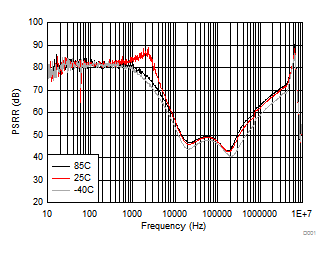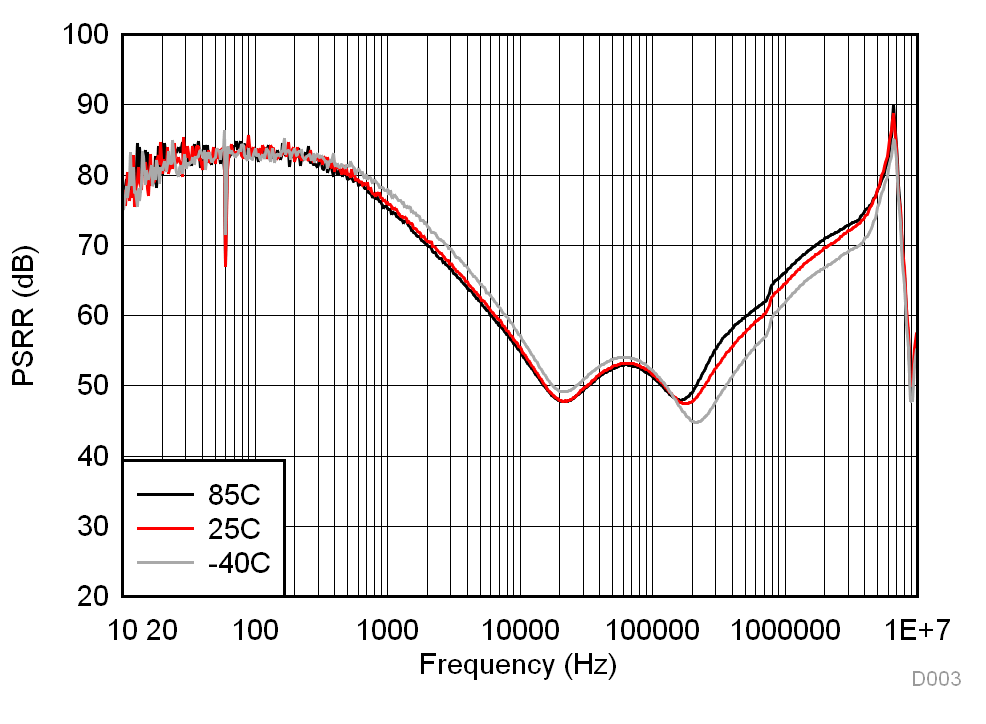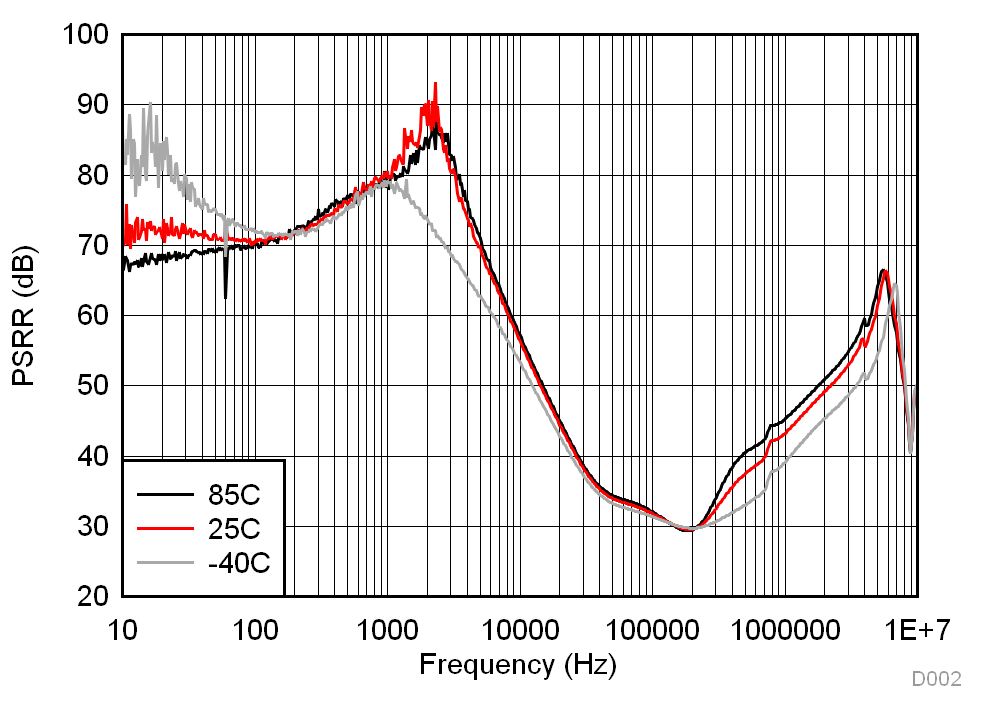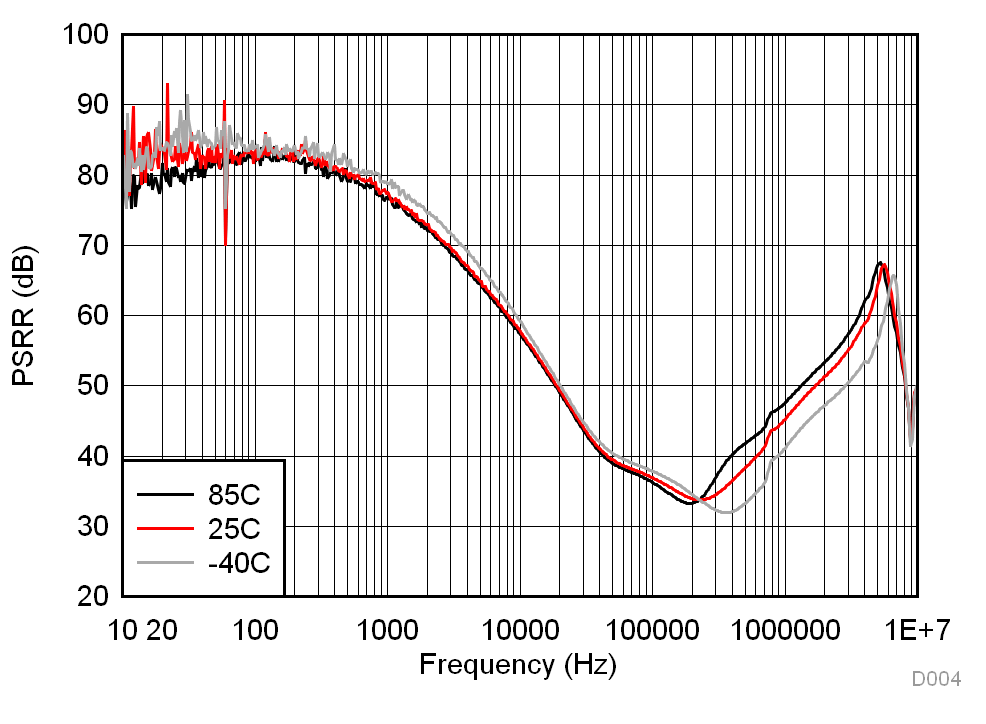SLVSCW2A September 2015 – February 2016 TPS657095
PRODUCTION DATA.
- 1 Features
- 2 Applications
- 3 Description
- 4 Revision History
- 5 Pin Configuration and Functions
- 6 Specifications
-
7 Detailed Description
- 7.1 Overview
- 7.2 Functional Block Diagram
- 7.3
Feature Description
- 7.3.1 State Diagram
- 7.3.2 Power-up Timing
- 7.3.3 GPO
- 7.3.4 GPIO
- 7.3.5 LED_EN
- 7.3.6 PWM Dimming
- 7.3.7 Crystal Oscillator and CLKOUT
- 7.3.8 LDOs
- 7.3.9 Undervoltage Lockout
- 7.3.10 Power Up/Power Down Default States
- 7.3.11 Output Voltage Discharge for LDO1 and LDO2
- 7.3.12 Power-Good Status Bits for LDO1 and LDO2
- 7.3.13 Short-Circuit Protection
- 7.3.14 Thermal Shutdown
- 7.3.15 LED Driver
- 7.3.16 4kByte OTP Memory
- 7.4 Device Functional Modes
- 7.5 Programming
- 7.6
Register Map
- 7.6.1 DEV_AND_REV_ID Register Address: 00h
- 7.6.2 OTP_REV Register Address: 01h
- 7.6.3 GPIO_CTRL Register Address: 02h
- 7.6.4 PWM_OSC_CNTRL Register Address: 03h
- 7.6.5 ISINK_CURRENT Register Address: 04h
- 7.6.6 LDO_CTRL Register Address: 05h
- 7.6.7 LDO1_VCTRL Register Address: 06h
- 7.6.8 LDO2_VCTRL Register Address: 07h
- 7.6.9 PWM_DUTY_THR_L Register Address: 08h
- 7.6.10 PWM_DUTY_THR_H Register Address: 09h
- 7.6.11 RESERVED Register Address: 0Ah
- 7.6.12 PWM_DUTY_L Register Address: 0Bh
- 7.6.13 PWM_DUTY_H Register Address: 0Ch
- 7.6.14 RESERVED Register Address: 0Dh
- 7.6.15 SPARE Register Address: 0Eh
- 7.6.16 4K_OTP_PASSWORD Register Address: 0Fh
- 8 Application and Implementation
- 9 Power Supply Recommendations
- 10Layout
- 11Device and Documentation Support
- 12Mechanical, Packaging, and Orderable Information
6 Specifications
6.1 Absolute Maximum Ratings
over operating free-air temperature range (unless otherwise noted)(1)| MIN | MAX | UNIT | ||
|---|---|---|---|---|
| Voltage | All pins except GND pin with respect to AGND | –0.3 | 7 | V |
| GPIO and GPO pull-up voltage if configured as open drain output | -0.3 | VCC + 0.3 | V | |
| Pin VLDO1 and VLDO2 with respect to AGND | –0.3 | 3.6 | V | |
| Current | VLDO1, VLDO2, VCC | 200 | mA | |
| GND, ISINK, GPIO, GPO | 50 | mA | ||
| All other pins | 3 | mA | ||
| Operating free-air temperature, TA | –40 | 85 | °C | |
| Maximum junction temperature, TJ | 125 | °C | ||
| Storage temperature range, Tstg | –65 | 150 | °C | |
(1) Stresses beyond those listed under absolute maximum ratings may cause permanent damage to the device. These are stress ratings only and functional operation of the device at these or any other conditions beyond those indicated under recommended operating conditions is not implied. Exposure to absolute-maximum-rated conditions for extended periods may affect device reliability.
6.2 ESD Ratings
| VALUE | UNIT | |||
|---|---|---|---|---|
| V(ESD) | Electrostatic discharge | Human body model (HBM), per ANSI/ESDA/JEDEC JS-001(1) | 2000 | V |
| Charged device model (CDM), per JEDEC specification JESD22-C101(2) | 500 | V | ||
(1) JEDEC document JEP155 states that 500-V HBM allows safe manufacturing with a standard ESD control process.
(2) JEDEC document JEP157 states that 250-V CDM allows safe manufacturing with a standard ESD control process.
6.3 Recommended Operating Conditions
over operating free-air temperature range (unless otherwise noted)| MIN | NOM | MAX | UNIT | ||
|---|---|---|---|---|---|
| VCC /AVCC | Input voltage range | 3.7 | 6 | V | |
| CVCC | Input capacitor at VCC | 1 | µF | ||
| CAVCC | Input capacitor at AVCC | 1 | µF | ||
| VLDOx | Output voltage range for LDO1 and LDO2 | 0.8 | 3.3 | V | |
| ILDO | Output current at LDO1 or LDO2 | 75 | mA | ||
| COUTLDO1/2 | Output capacitance at VLDO1, VLDO2 | 2.2 | 6.8 | µF | |
| LED_EN | Voltage range | 1.3 | 6 | V | |
| GPIO | Voltage range (configured as an input) | 1.3 | 3.3 | V | |
| TA | Operating ambient temperature | –40 | 85 | °C | |
| TJ | Operating junction temperature | –40 | 125 | °C | |
6.4 Thermal Information
| THERMAL METRIC(1) | TPS657095 | UNIT | |
|---|---|---|---|
| YFF (DSBGA) | |||
| 16 PINS | |||
| RθJA | Junction-to-ambient thermal resistance | 78.2 | °C/W |
| RθJC(top) | Junction-to-case (top) thermal resistance | 0.6 | |
| RθJB | Junction-to-board thermal resistance | 13.2 | |
| ψJT | Junction-to-top characterization parameter | 2.5 | |
| ψJB | Junction-to-board characterization parameter | 13 | |
| RθJC(bot) | Junction-to-case (bottom) thermal resistance | n/a | |
(1) For more information about traditional and new thermal metrics, see the IC Package Thermal Metrics application report, SPRA953.
6.5 Electrical Characteristics
Unless otherwise noted: VCC = AVCC = 5V, CVCC = 1µF; COUTLDOx= 2.2µF, TA = –40°C to 85°C6.6 Timing Requirements
| MIN | MAX | UNIT | ||
|---|---|---|---|---|
| fMAX | Clock frequency | 400 | kHz | |
| t(HIGH) | Clock high time | 600 | ns | |
| t(LOW) | Clock low time | 1300 | ns | |
| tr | DATA and CLK rise time | 300 | ns | |
| tf | DATA and CLK fall time | 300 | ns | |
| thd;STA | Hold time (repeated) START condition (after this period the first clock pulse is generated) | 600 | ns | |
| tsu;STA | Setup time for repeated START condition | 600 | ns | |
| thd;DAT | Data input hold time | 10 | ns | |
| tsu;DAT | Data input setup time | 100 | ns | |
| tsu;STO | STOP condition setup time | 600 | ns | |
| tBUF | Bus free time | 1300 | ns | |
| Cl | Load capacitance on SDA and SCL (with a 730Ω or smaller pull-up resistor on SDA and SCL pulled up to 1.8V) | 400 | pF | |
 Figure 1. Serial I/f Timing Diagram
Figure 1. Serial I/f Timing Diagram
6.7 Typical Characteristics



